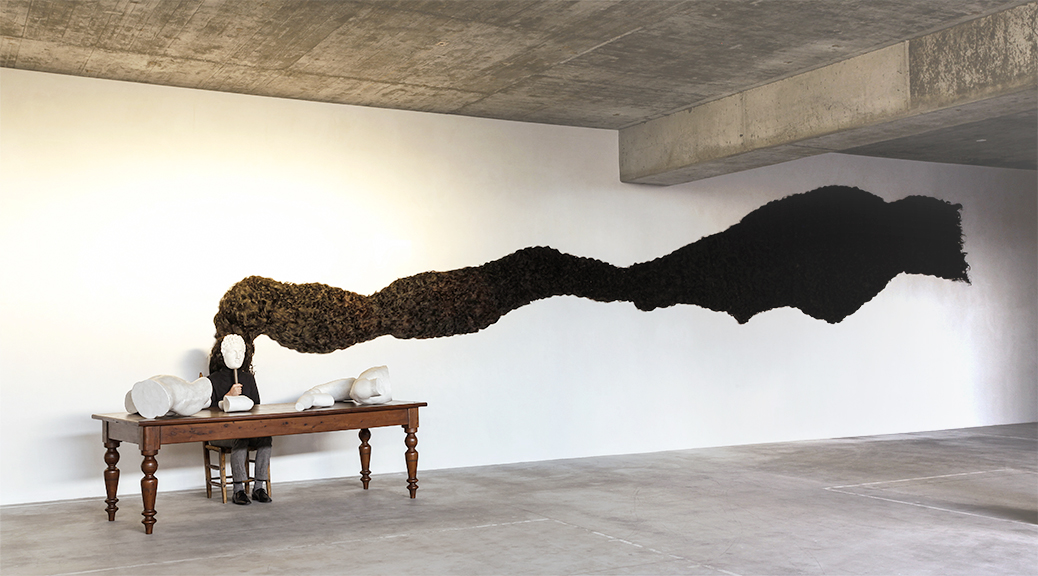Jannis Kounellis
Senza titolo, 1975
„Frammenti di memoria“, Bruchstücke der Erinnerung, liegen auf einem langen Tisch, an dem 1975 der Künstler Jannis Kounellis sass und sich eine Maske vor das Gesicht hielt. Die Maske ist wie die Bruchstücke nach dem Gipsabguss einer antiken Skulptur, vermutlich einem Apollo, entstanden. Sinnbildlich tritt der Künstler mit seiner Aktion an die Stelle des griechischen Gottes der Künste und der Prophezeiung (vergleiche auch Kounellis‘ „Apollo“ von 1973; Hallen-Programm 2/2012). Aus der Maske geht ein zehn Meter langes Band aus echtem dunklen Haar hervor, das sich wie eine Rauchwolke auf der Wand ausbreitet und die Macht des Gottes zu symbolisieren scheint. In der Antike weihten die Jünglinge beim Übergang ins Mannesalter und der damit verbundenen Aufnahme in die Gesellschaft ihr Haar den Göttern und baten damit um künftigen Schutz. In den Haaren wurde eine gesteigerte Lebenskraft vermutet. Auch in Kounellis‘ Werk lässt die physische Wirkung der gewaltigen Haarmähne eine spürbare Kraft entstehen. Als faszinierende und geheimnisvolle Spannung breitet sie sich im Raum aus. Sie erzeugt einen Sog, dem sich die Phantasie der Betrachter kaum entziehen kann.
Die grosse Installation ist ein Hauptwerk des griechischen Künstlers Jannis Kounellis. Geschaffen aus dem Fundus seines mythologischen Formenvokabulars ist hier eine Verbindung von grösster Intensität entstanden – in metaphorische Sprache sind Vergangenheit und Zukunft ineinander verwoben. In Kounellis‘ Gesamtwerk wurde dieses Werk zu einem Ausgangspunkt für weitere Kompositionen mit vielschichtiger Bedeutungsebene. Die Verbindung der aus der Antike entlehnten Bruchstücke mit natürlichem lebendigen Material markiert einen Höhepunkt in einer Werk-Metamorphose, deren Spuren sich bis in Kounellis‘ späte Werke abzeichnen.Jannis Kounellis
Senza titolo, 1975
“Frammenti di memoria” – fragments of memory – lie as plaster pieces that associate an antique sculpture, probably an Apollo, almost weightless on a long table. In an earlier action, a person sat here like an actor from antiquity and held Apollo’s mask in front of his face. The person figuratively supplants the Greek god, who is both the God of the arts as well as prophecy (see also Kounellis’ “Apollo” from 1973; Hallen program 2/2012). A ten-meter strand of authentic dark hair extends from the mask; it spreads onto the wall like a cloud of smoke and seems to symbolize the god’s power. In antiquity, the younglings consecrated their hair to the gods upon becoming men and being admitted to society. It was a request for protection in the future; one suspected that hair was a powerful source of vitality. In Kounellis’ work, the physical presence of the massive mane of hair releases a force that expands into the space as a fascinating and cryptic tension. It creates a maelstrom from which the observer’s fantasy can hardly escape.
The large installation is one of the Greek artist Jannis Kounellis’ major works. Created from the stock of his mythological vocabulary, forms and materials enter into a connection with ultimate intensity – a metaphorical unification of past and future. In Kounellis’ oeuvre, “Senza titolo” became a starting point for further compositions with multi-faceted levels of meaning. In the transition from fragments derived from antiquity into a vivid current of hair, it marks a highlight within a metamorphosis of his work; its traces reach all the way into Kounellis’ late period.
